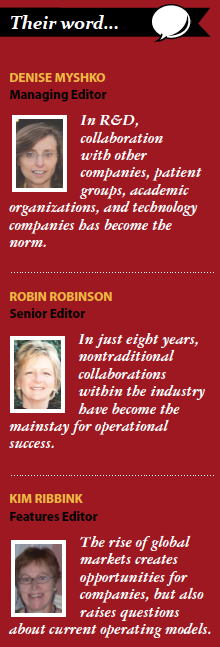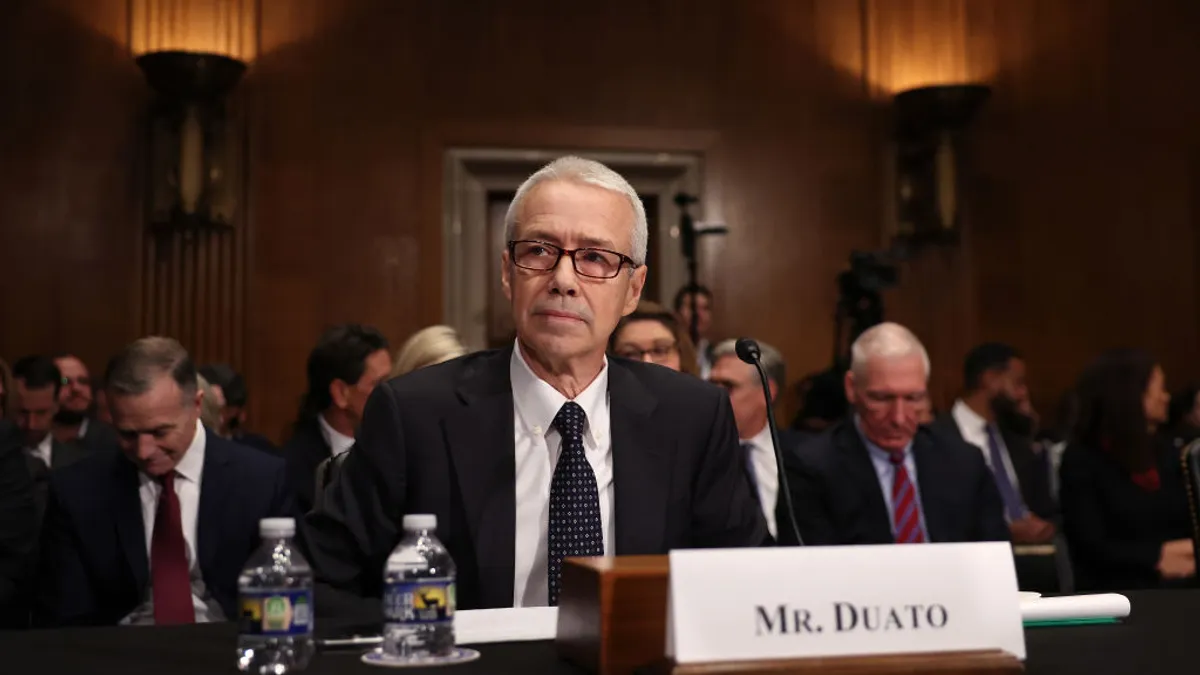Working in concert
 The act of collaborating with competitors, no less with companies and organizations outside of traditional “pharma," was a concept that might have been considered heresy — until recently. Sure, there were agreements with academic centers or cross-licensing deals to capitalize on markets not accessible by in-house feet on the ground, but now companies are proactively and with great expectations sharing data once held close to R&D vests. Why now? Why is this important? The answers lie in the increasingly complex ecosystem we call healthcare and the number of hard-to-treat diseases that are yet to be resolved.
The act of collaborating with competitors, no less with companies and organizations outside of traditional “pharma," was a concept that might have been considered heresy — until recently. Sure, there were agreements with academic centers or cross-licensing deals to capitalize on markets not accessible by in-house feet on the ground, but now companies are proactively and with great expectations sharing data once held close to R&D vests. Why now? Why is this important? The answers lie in the increasingly complex ecosystem we call healthcare and the number of hard-to-treat diseases that are yet to be resolved.
KPMG reports that the majority of the 400 U.S. chief executives surveyed say the next three years will be more critical for industries than the past 50. Why? Because as disruptive competitors, business models, and technologies threaten business as usual, CEOs have an unprecedented opportunity to reinvent their businesses and drive new growth. To navigate change and seize opportunities, KPMG analysts say CEOs will need to foster innovation, step up customer focus, collaborate externally, and transform their businesses in numerous other ways. Despite the unknown obstacles and sharp turns on the road ahead, they are optimistic about where their journey will take them over the next three years.
For this special issue, we tapped experts from across the life-sciences industry and asked them to provide their insights on this new era of collaboration as well as the drivers, challenges, and the journey ahead.
Mike Rea, president of IDEA Pharma, whose company tracks innovation across the industry, notes that the collaborative nature of drug development should be delivering what people want instead of what it’s convenient for companies to provide. Further, he says this will only come about through collaboration. When the drug gets to market, companies will need to address whose problem they solved.
There are thousands of collaborations happening throughout the industry, and while it may be difficult for some organizations to embrace partnering with competitors, the most important change for pharma to make is switching the business model focus from generating high revenue to improving the health and lives of the end user — in other words, to become patient-centric from the very first phase of discovery.
Our experts agree that a successful collaboration must provide value to patients and their overall healthcare, or it will appear that companies are just looking out for their own business benefits.
PwC analysts state collaboration will be a “do or die" requirement for pharmaceutical companies and healthcare payers alike. They also say as various forces are changing the environment in which the pharma industry operates and the relative positions of the different players in the healthcare arena, there will be a need for much greater collaboration now and in the future.
Taren Grom, Editor
~~~~~~~~~~~~~~~~~~~~~~~~~
Their word…
Denise Myshko
Managing Editor
In R&D, collaboration with other companies, patient groups, academic organizations, and technology companies has become the norm.
Robin Robinson
Senior Editor
In just eight years, nontraditional collaborations within the industry have become the mainstay for operational success.
Kim Ribbink
Features Editor
The rise of global markets creates opportunities for companies, but also raises questions about current operating models.
~~~~~~~~~~~~~~~~~~~~~~~~~
Coming in May 2017
Giving Back—Industry Philanthropy
Behind the Brand
Nobel Science
HBA’s Rising Stars and Luminaries
Disease State: Hepatitis
Rare Disease: Patient Recruitment
Showcase Feature: mHealth
~~~~~~~~~~~~~~~~~~~~~~~~~
Masthead
Volume 17 • Number 4
Publisher Lisa Banket
Editor Taren Grom
Creative Director Marah Walsh
Managing Editor
Denise Myshko
Senior Editor
Robin Robinson
Features Editor
Kim Ribbink
Design Associate
Ariel Medel
Director of Sales
Cathy Tracy
National Account Manager
Suzanne Besse
Webcast Network Producer
Daniel Limbach
Circulation Assistant
Kathy Deiuliis
Copyright 2017
by PharmaLinx LLC, Titusville, NJ
Printed in the U.S.A.
Volume Seventeen, Number Four
PharmaVoice (ISSN: 1932961X) is published monthly except joint issues in July/Aug. and Nov./Dec., by PharmaLinx LLC, P.O. Box 327, Titusville, NJ 08560. Periodicals postage paid at Titusville, NJ 08560 and additional mailing offices.
Postmaster: Send address changes to PharmaVOICE, P.O. Box 292345, Kettering, OH 45429-0345.
PharmaVoice Coverage and Distribution:
Domestic subscriptions are available at $190 for one year (10 issues). Foreign subscriptions: 10 issues US$360. Contact PharmaVoice at P.O. Box 327, Titusville, NJ 08560. Call us at 609.730.0196 or FAX your order to 609.730.0197.
Contributions: PharmaVoice is not responsible for unsolicited contributions of any type. Unless otherwise agreed in writing, PharmaVoice retains all rights on material published in PharmaVoice for a period of six months after publication and reprint rights after that period expires. E-mail: [email protected].
Change of address: Please allow six weeks for a change of address. Send your new address along with your subscription label to PharmaVoice, P.O. Box 292345, Kettering, OH 45429-0345. Call us at 800.607.4410 or FAX your change to 937.890.0221. E-mail: [email protected].
Important notice: The post office will not forward copies of this magazine. PharmaVoice is not responsible for replacing undelivered copies due to lack of or late notification of address change.
Advertising in PharmaVoice: To advertise in PharmaVoice please contact our Advertising Department at P.O. Box 327, Titusville, NJ 08560, or telephone us at 609.730.0196. E-mail: [email protected].



















